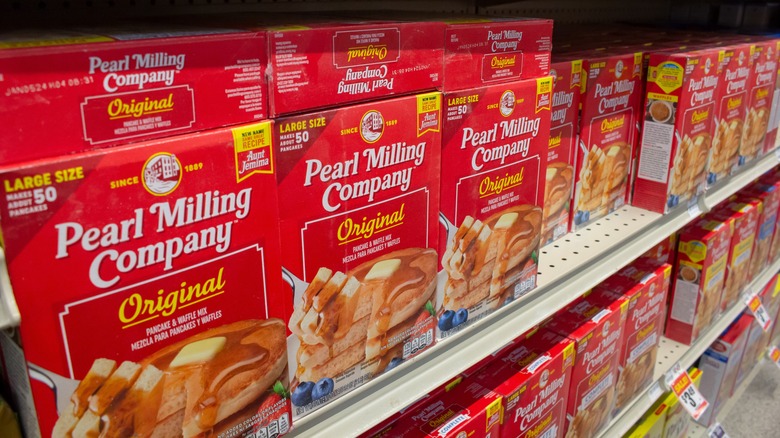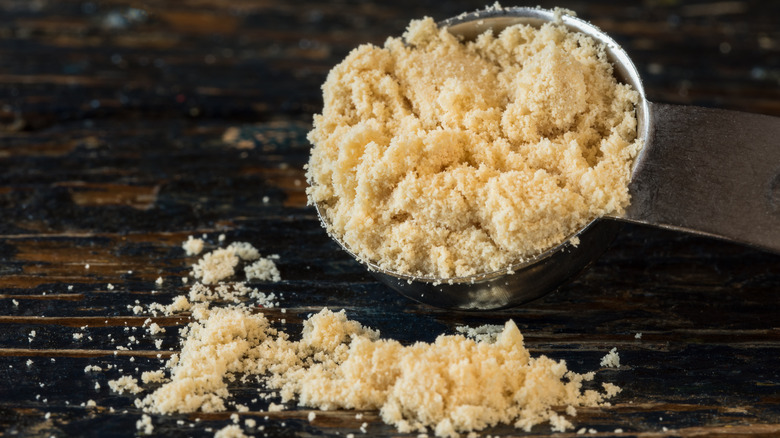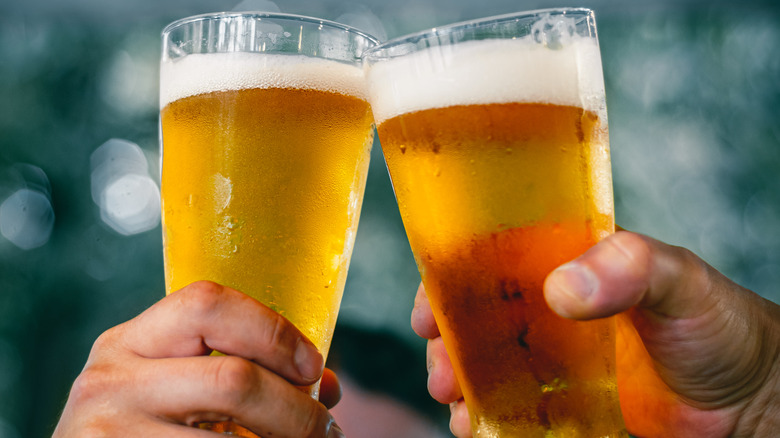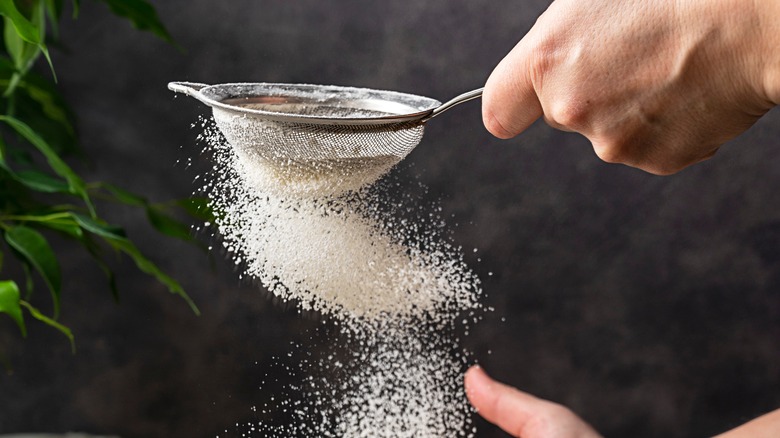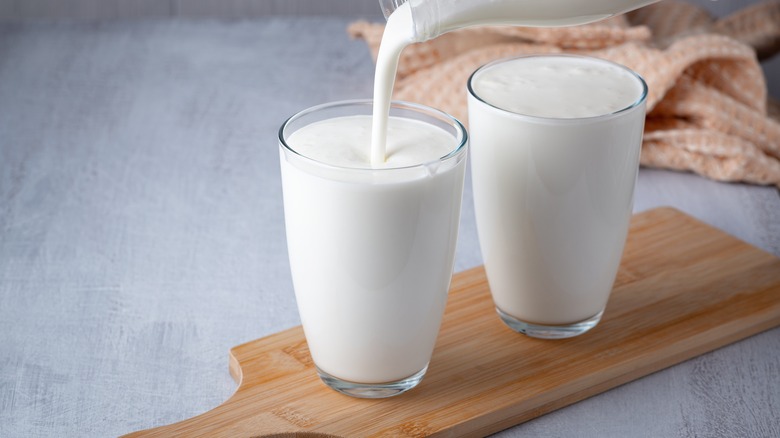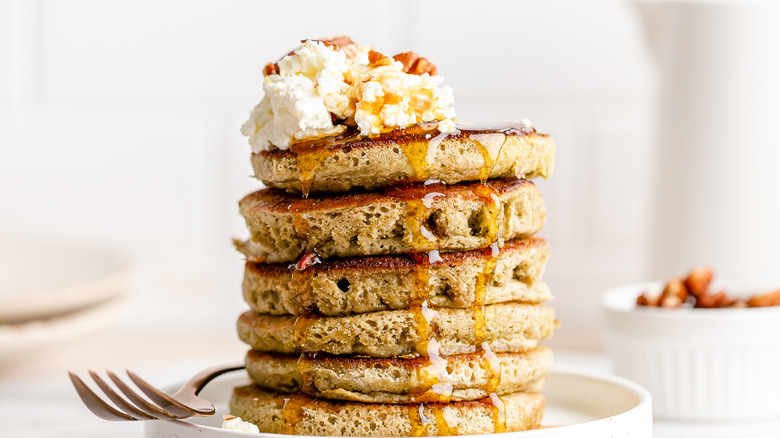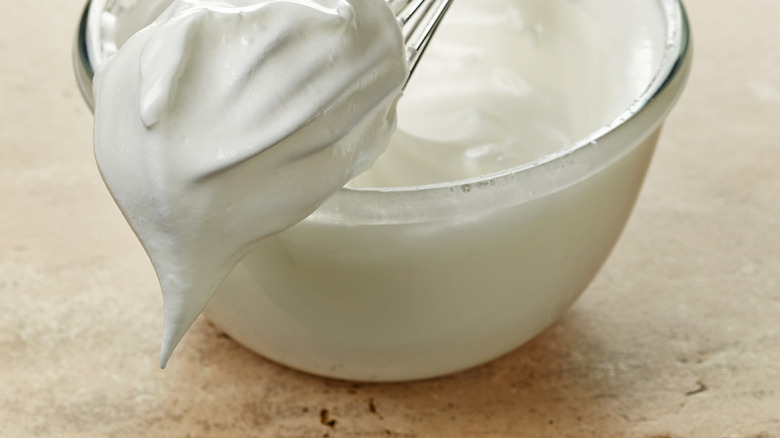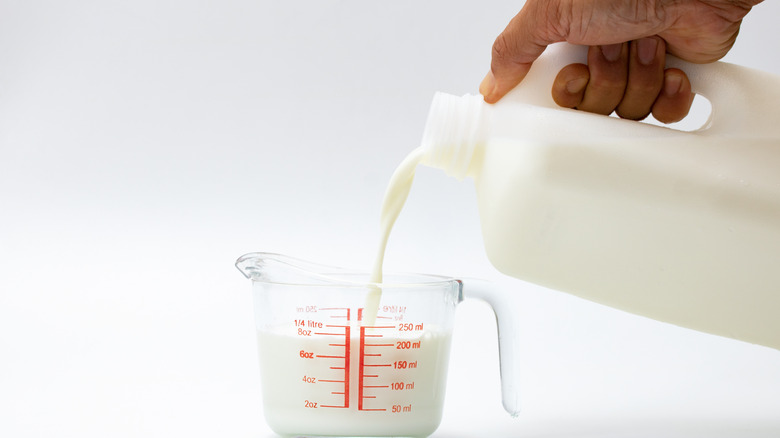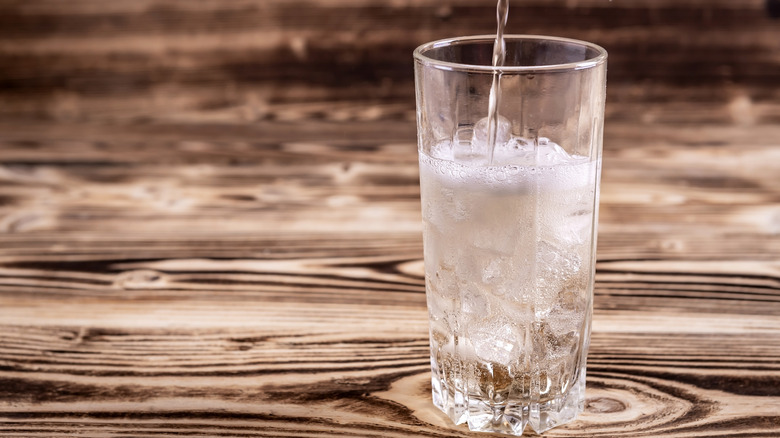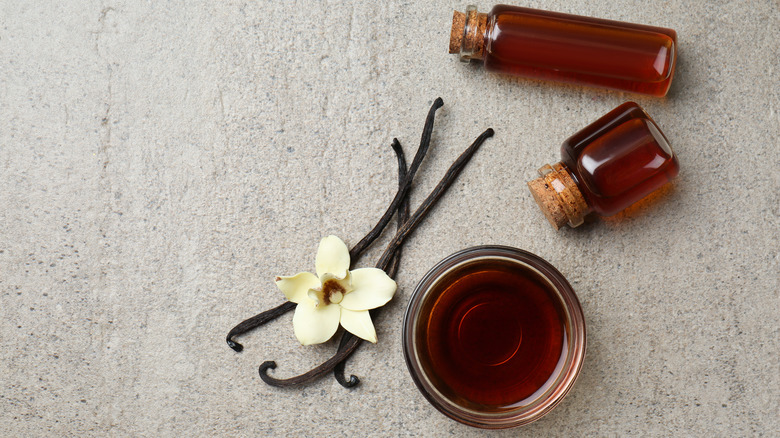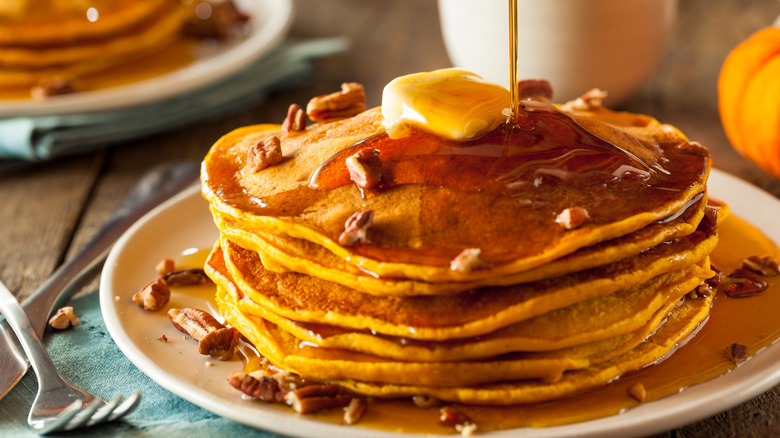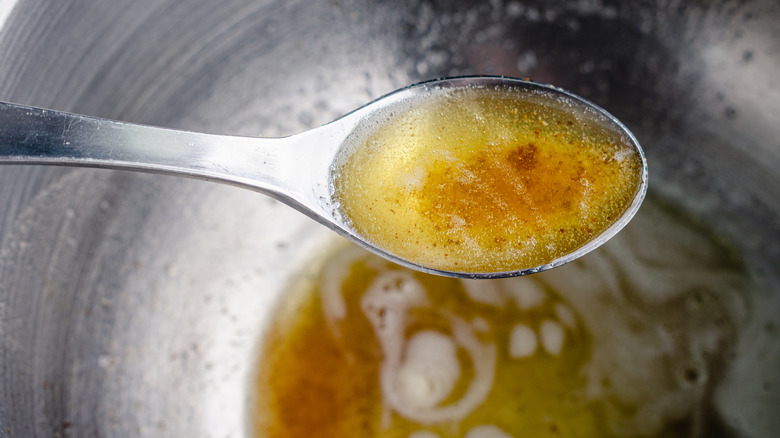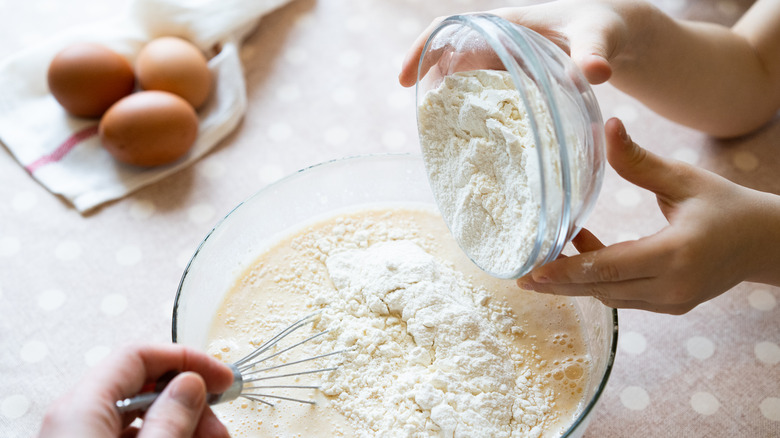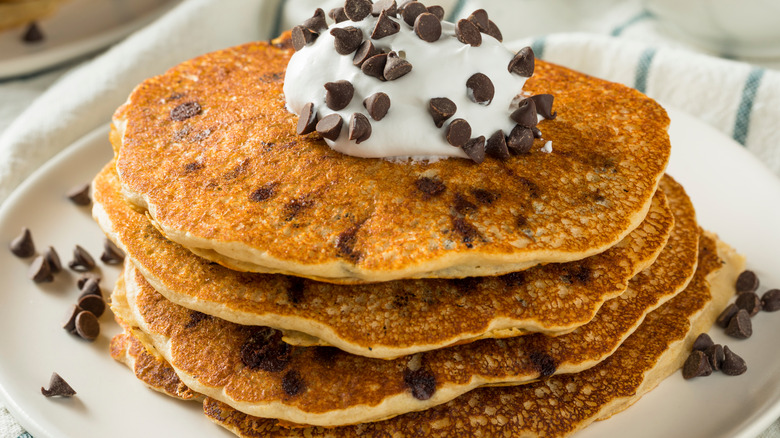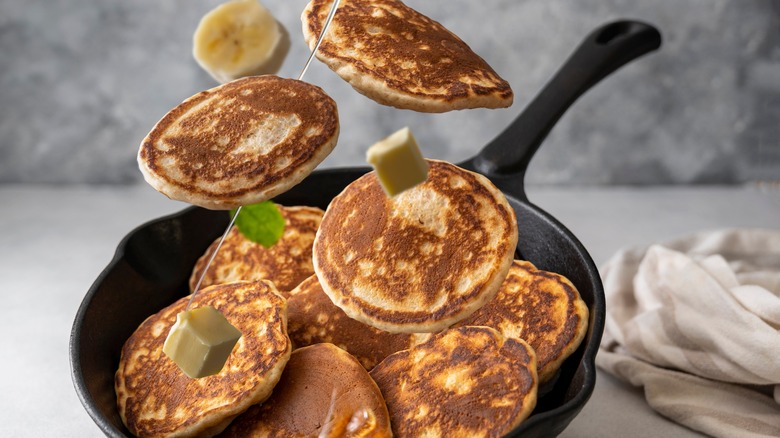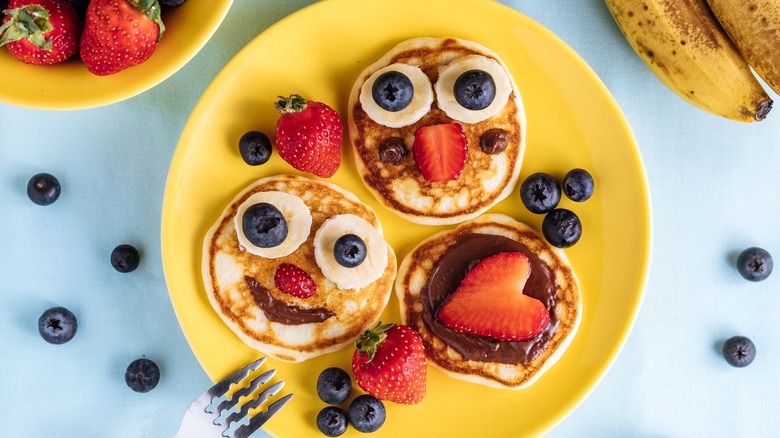15 Tips You Need To Elevate Boxed Pancake Mix
Boxed pancake mix can be your saving grace on a Sunday morning. Not only is this convenient mixture relatively inexpensive to purchase, but it is even easier to make. Most recipes require just adding water, mixing, and pouring into a hot skillet for breakfast in under 10 minutes. But how much do you know about boxed pancake mix and how to take it to another level?
The first ready-to-make pancake mix debuted in the 1880s as a response to a surplus of flour available on commodity markets. The original recipe for these pancakes included white winter wheat, corn flour, salt, and leavening agents. However, it wasn't until several years later that companies started to add milk powder to the mixture for a better rise and more complex flavor. The modern recipe for boxed pancake mix remains the same, with some brands offering gluten-free, high-fiber, or protein-added products. Here are some of our favorite ways to elevate the humble pancake mix into something that will make your Sunday morning tastebuds sing.
Add malted milk powder for a diner-like pancake
Why do people order pancakes at diners rather than make them at home? Besides the apparent ease and convenience, there is a clear difference in the flavor of diner pancakes and pancakes made in your kitchen. Diner pancakes are often thicker and more umami in taste because of an unexpected ingredient added to the pancakes: malted milk powder. This powdered mixture of barley malt and wheat can also be found in other recipes and culinary applications, such as in malt ball candies or classic soda fountain milkshakes.
While some pancake mixes add some of this ingredient to their pre-made dry batter, you should keep a canister of the powder on-hand to add to your batter. We recommend starting with a single tablespoon of malted milk powder and adding more or less to subsequent recipes depending on your desired taste. We should note that because malted milk powder is made with barley and wheat, it is unsuitable for gluten-free pancake mixes.
Pour one out for your pancakes
You might not be reaching for a Sam Adams at 8 a.m. on a Sunday — but if you're making pancakes, you have a good excuse. However, though beer might seem like an unexpected liquid to take your pancakes up a notch, take a second to think about the flavor and properties of this beverage. The bubbles in the beer are an easy way to incorporate more air into the batter. In contrast, the hoppy flavor of the beer adds a savory layer of complexity that pairs well with the sweetness of syrup or the richness of a butter topping.
If you try this hack at home, you should try to use light beer and only add the liquid to the batter with the rest of your wet ingredients. In this case, using a cheap beer, like a Natty Light, is preferable because the beer's flavor will provide just enough oomph without overpowering the rest of the flavors. Add the cold beer at the end of the cooking time for maximum carbonation to prevent the bubbles from fizzling out.
Always sift your dry ingredients
Why would anyone take the ease of a boxed, pre-made dry pancake mix a step further by sifting it? Although sifting your dry mixture using a kitchen sieve isn't the picture-perfect definition of "three-step" pancakes, it will tremendously impact the texture and structure of the pancake. Sifting both break up any large chunks of dry ingredients in your pancakes and incorporates more air into your boxed pancake mix. When sifting your pancake mixture, you should be sure to hold the sieve over a foot above the bowl; this will incorporate the most air into the ingredients as they fall into the bowl.
Sifting your pancake batter before you add the wet ingredients is critical because it will counteract some of the air bubbles lost during mixing. Mixing the batter to beat out those clumps will remove more air bubbles from the batter and potentially cause it to come out stodgy.
Use buttermilk as your liquid of choice
Buttermilk and pancakes together are a match made in heaven. Substituting buttermilk for other liquids in your pancake batter will easily elevate a boxed pancake mix because it is much creamier, thicker, and tangier. You can use a 1-to-1 substitution for these liquids for the ultimate fluffy and tasty flapjacks. If you're making a dairy-free pancake mix, you can make a vegan buttermilk by combining a couple of tablespoons of vinegar with your milk of choice.
There is a lot of science behind why buttermilk is the ideal ingredient to add to pancakes. Buttermilk contains more acid than milk or water, which acts as a chemical leavening agent when it interacts with the baking soda or baking powder in the batter. The carbon dioxide produced by the interaction helps give the pancakes some structure and keeps them super soft. Adding an acidic ingredient can also help slack some gluten strands that would otherwise make pancakes chewier.
Use Giada De Laurentiis' recipe
Food Network television star Giada De Laurentiis knows a few things about cooking. De Laurentiis levels up the boxed pancake mix by adding three special ingredients: almond paste, almond extract, and mascarpone cheese. She mixes together the thick cheese and almond extract with water, sugar, and a splash of vanilla extract. The almond paste comes in after the pancake mix has been added. Then, the pancakes are transferred to the skillet and cooked until brown.
You may not have thought to add cheese to your boxed pancake mix, but this small step can drastically improve the flavor and the moistness of your flapjacks. In addition, you won't have to worry about moisture evaporating as the pancakes cook, which is essential for a soft, plush stack. Almond paste, when combined with the almond extract, can help add a layer of nuttiness to your pancakes, too. Just be sure to measure the almond extract precisely, as adding too much can upset the delicate balance of flavors.
Whip your egg whites before adding them to the batter
Good pancakes are fluffy pancakes. It's the reason why you should go the extra step to not only add an egg to your pancake batter but separate and whip the whites, too. The yolk of the egg adds an extra element of fat, while the whipped egg whites provide an unmistakable structure and stability to the pancakes.
You'll need to use about one egg for each cup of pancake mixture you use. After separating the two components, add ⅛ teaspoon of cream of tartar to prevent your eggs from deflating. Next, start whipping your whites by hand with a balloon whisk, or stick to an electric beater. Once stiff peaks have formed, you can incorporate the eggs into your batter using a series of deliberate, soft folds. It is essential not to beat all the air out of the egg whites when you combine it with the pancake batter, as this may not create the light, airy texture you worked so hard to create.
Substitute the water for milk
Most pancake recipes require you just to add water to the dried mix. But instead of rushing for the tap, you should rush to your fridge instead. Substitute equal parts milk for water in the pancake recipe for a much better flavor and texture. While some companies already use powdered milk in their pancake mix, adding a bit of liquid milk can help make your flapjacks more unctuous — since milk contains more fat than water.
If you make a dairy-free pancake recipe, you can substitute your favorite dairy-free beverage for water. It is important to remember that not all dairy milk has the same fat content or consistency as regular milk, so you may not see the same results if you use a dairy-based addition. Oat milk is one of our favorites for pancakes because it has a thick texture and a flavor that does not upset the others in the batter.
Use seltzer water for a fizzy boost
Fizzy water is the only thing better than adding regular water (besides buttermilk or regular milk). Seltzer water contains carbonation, which can help add more air to your pancake batter. Adding seltzer water is the secret to fluffy gluten-free pancakes because it helps soften the pancake batter, but the trick can also be used for regular wheat pancakes.
If you want to substitute seltzer water for your recipe, you'll want to use equal parts seltzer for other liquids in the batter. If you're going to get the creamy taste of adding milk without missing out on the fizziness of the seltzer, you can use a smaller ratio of each in the batter. Like adding beer to your pancakes, you should always add the liquid at the end of your prep process. This will maximize the bubbles you get in your pancakes and prevent the leavening agents from working too quickly, thus causing your pancakes to deflate.
Add extracts for more flavor
Extracts are an easy way to add more flavor to your pancakes without upsetting the overall flavor tone of your pancake. One of our favorite ways to lighten up pancake batter is to add a bit of orange extract with the rest of your wet ingredients. The orange will add a fruity spin to the breakfast dish, which can be made more intense by adding the orange zest to the batter and on top of the pancake. Moreover, orange extract pairs well with chocolate chips and a bit of ricotta cheese. Cannoli pancakes, anyone?
Vanilla is one of the more common extracts used in pancakes. The flavor of the vanilla extract is not as overpowering as other types (which, if you add more than a ½ teaspoon, may set you into dangerous territory). You can also use almond extract but always measure it in a separate vessel before pouring it into the batter.
Spice your flapjacks up
If you want to go a step above adding extracts to your pancakes, your next stop should be your spice cabinet. There are tons of different warming spices that can add a layer of complexity to your pancakes and make any boxed pancake mix taste homemade. Our favorite standard pancake additions include cinnamon and nutmeg. Both pair well with fall-inspired toppings like warmed cinnamon apples, pumpkin, and pecans. You can also use spice blends, like apple pie and pumpkin pie spice, to provide a medley of toasty spices to your next stack.
You can also venture into unique spices like gingerbread spice — which includes cinnamon, allspice, black pepper, and ginger. The black pepper and the ginger provide a subtle heat on the back of your throat. You can also use chai spice, which is heavier on the cardamom and cinnamon than pumpkin pie spice and apple pie spice.
Use melted butter
The definitive way to make anything better? Add butter. Any sort of fat is critical in pancakes because it makes the flapjacks moist. However, adding too much fat can cause issues with the density of the pancake and result in a poor rise. On the other hand, too little butter will produce a crispy pancake that shatters when you bite into it. You can safely add 1 tablespoon of melted butter to each cup of pancake batter you make. If you want an even toastier flavor, try browning your butter before adding it to the pan. Heat a few tablespoons of butter in a pan over medium-high heat until tiny flecks of brown start to form and the mixture emits a nutty aroma.
It is important to remember that butter belongs in your pancake rather than in the pan. Since butter has a low smoke point, it tends to burn the outside of the pancake and leave behind a bitter residue. Instead, use a high-smoke point oil, like canola or vegetable oil, to grease your pan before adding the batter.
Be sure to avoid overmixing the batter
One of the most common mistakes people make with pancakes is over-mixing the batter. Stirring the batter too much with a whisk or a spoon will come to the detriment of the batter for several reasons. The first is that beating out the tiny lumps of flour will cause you also to beat out the carbon dioxide that gives the pancake its rise. In turn, this defeats the work of your leavening agents (the baking soda and baking powder), rendering your pancakes flat and hard. Instead, leave the small flour lumps in your batter; it will all work out when you cook the pancakes.
Gluten is also not your friend when you're making pancakes. This protein forms when liquid is added and mixed into the batter. Although it provides some structure to the pancake, too much mixing can make the batter stiff and stodgy. You only have to stir the batter a few times to ensure no dry spots; once you've reached that point, put down the spatula.
Add mix-ins with care
Some of the simplest ways to add more flavor to your pancakes are to add special mix-in ingredients into the pancake batter to add more complexity. Some of these ingredients include nostalgic chocolate chips or fresh blueberries. If you like the taste of sweet and savory, try cooking and chopping up leftover bacon for your pancakes. Finally, if you want to embrace your inner youth, try taking your pancakes to the next level by mixing in some boxed cake mix with your pancake batter. You'll get a subtle sweetness and a bit of cake-like texture — and don't forget about the sprinkles.
Regardless of your desired ingredients, the key is not to add too many of your mix-ins. Adding more than just a few handfuls of ingredients can cause your pancake to lose its fluffy qualities and sink down your batter. Instead, limit yourself to one or two-mix ins and avoid adding more than the recipe on the box notes.
Cook your pancakes in a cast-iron skillet
There are many debates out there about how best to cook pancakes. However, the classic method of cooking pancakes on a non-stick pan is outdated. This is because the pan doesn't retain enough heat to develop an even brownness. Instead, you should use a well-seasoned, cast-iron skillet for cooking your pancakes. The seasoning (and adding oil or clarified butter before the batter) will keep the pancakes from sticking and develop a robust and beautiful color. Alternatively, you can use the classic non-stick griddle for cooking pancakes. This griddle is made explicitly for cooking foods like pancakes. In addition, many of these kitchen appliances are flat, making it easy to flip your pancakes, and have a knob that makes changing the temperature of the surface easy. Plus, you can cook more pancakes at a time using a griddle rather than a standard pan.
If you are making pancakes for a crowd, your other alternative method is to bake the pancake batter in a baking dish and cut the pancakes into pieces to serve. This method saves you a ton of time and stress compared to cooking pancakes on a stove.
Get creative with your toppings
After you've finished the arduous task of making your pancakes, it's finally time to decorate and eat them. You can stick with your standard pancake toppings of maple syrup and butter or get more creative. For example, The Rock tops his banana pancakes with a mixture of peanut butter and jelly — which we think is the perfect topping combination if you like the medley of sweet and savory.
If you don't mind putting more time into your pancakes, you can also make a salted caramel sauce topping for your pancakes by cooking together butter, heavy cream, brown sugar, vanilla extract, and salt. Once the sauce has cooled, you can drizzle it on everything from pancakes to ice cream. We recommend pairing it with the nutty flavors of chopped pecans, and walnuts, or a drizzle of peanut butter and chocolate sauce.
Static Media owns and operates Tasting Table and Mashed.
